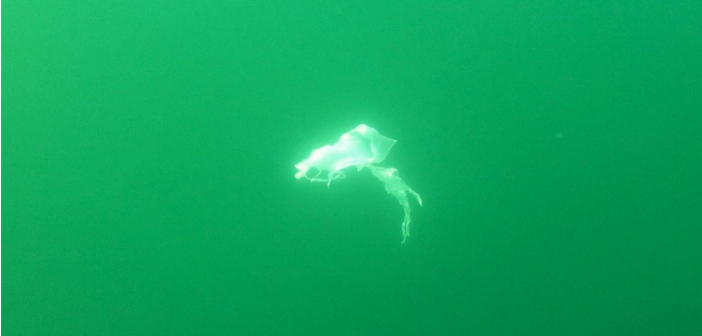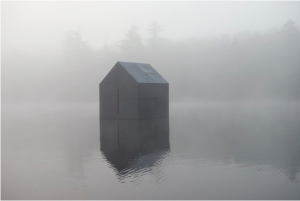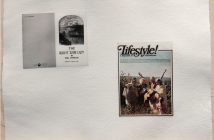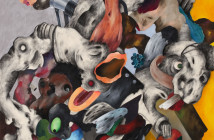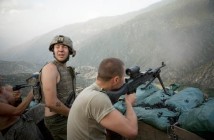Thoreau heard trains in Walden. There is the recorded sound of one in the exhibition Walden, revisited, on view through April 26 at the deCordova Sculpture Park and Museum, but there is nothing to suggest that it is anything other than a modern intrusion, rather than a report of Thoreau’s own experience. A rail line ran not far from his cabin. "The whistle of the locomotive penetrates my woods summer and winter," he writes in Walden, "sounding like the scream of a hawk sailing over some farmer's yard..." Although his simile tries to draw the machine into nature, there is a a lack of conviction to it, as if he felt obligated to make the attempt, but knew that it would not succeed. In any case, he was seeking a moral woods, not an authentic one. Paradise had already been lost by the time he reached it.
But the fantasies of Thoreau’s experience are a matter of continuing obsession in a culture that is not yet sure what to make of the natural world beyond either romance or betrayal. Curated with a keen sense for diverse voices by Dina Deitsch, this collection of work by sixteen artists at a site only a few miles from its geographical subject, directly confronts that ambiguity. In her ingenuously comic video piece One Week Walden, Jennifer Sullivan cheerfully asserts of her encounter with the book that "I didn’t actually finish it, but I got the basic idea." That statement can easily serve as our cultural common denominator regarding Thoreau.
There is a tradition of commentary which imagines Thoreau’s work as a lyrical science project, set apart by its antique botanical categories. This is the character of Spencer Finch’s Walden Pond (surface/depth). Fashioned in the form of a lead line used by sailors to measure shallow water, it becomes a Linnaean rope on land with its twisting, imaginary catalogue of specimens. Finch also created a collage of Impressionist postcards that are presented as documentary equivalents to his own visual mapping of the Walden Pond surface on a single morning. As a dictionary of light it is an imaginative rendering, but these particular choices suggest other possibilities. Corot and Millet were reading the sun at the same time as Thoreau was and knew the hard details of the landscape as he did. Even Edward Hopper and his wanderers in urban sunlight would recognize the water’s unstable mirror.
Gina Siepel’s rowboat in primary colors meant for resurveying Walden Pond hints at something precious in attitude that Thoreau never possessed, although Rat and Mole rowing along the river in The Wind in the Willows are perhaps the closest in spirit to a children’s version of Walden that there is, especially with its Greek mythology thrown in. It is Jane Marsching with Matthew Shanley who, by inscribing a history of ice using graphs of cold, is the more enlightening about the pond’s surfaces, even as they are reduced to abstractions.
Deb Todd Wheeler’s video, Searching for Imposters, imagines the submerged, invisible stories of the pond, with her billowing plastic bags a suggestion of Ophelia drowning in Walden, while the floating black cabin of William Lamson’s untitled image might be the ghost of Huck and Jim’s raft left to drift into the dark future of race in this country.
A work of the Futurefarmers collective entitled We have become the tool of our tools presents a log branded with an ax, an image which appears to render a tree capable of its own unmaking. This could be read as a counterpoint to the poet Audre Lorde’s assertion that, in the pursuit of justice, "the master’s tools will never dismantle the master’s house." Here, instead, is the tool that the master could use to demolish every house except his own. In another piece by the same group, Solitude Friendship Society, are the words enclosed in the wood really its own voice, or rather what it is being forced to say of itself?
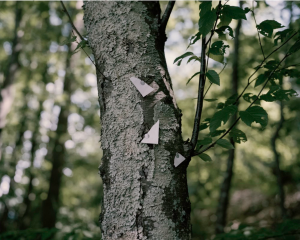
Oscar Palacio, Posted Sign on Tree, Walden Pond, MA, 2013. Inkjet print, 32 x 40 inches. Courtesy of the artist.
Myopic Wall Composition, by David Brooks, is a dissection of Nature into architectural elements. Displayed on an armature like those used to support anatomical models, it belongs in a morgue for the woods. Lisa Sigal’s Hinged Painting (Freshkills), uses window screens to filter the trash and muck of the landfill into a dream site for Thoreau’s cabin, to be rebuilt within the confines of an anti-Walden, the dump returned to nature.
In a recent New York Times essay entitled "Leaving Only Footsteps," the writer Christopher Solomon argues convincingly that even our most benign intrusions into nature (and they are rarely only that) result in disaster. Oscar Palacio’s photographs included in this exhibition could serve as the precise illustrations of that discovery. He traces the human in fragments left behind, some resembling the debris of a kidnapping, or a prison escape, underlining that peculiar paradox of nature’s reality being heightened in the presence of trash. And then there are the athletes who have made the circuit of Walden a place of physical exercise, running after immortality. Palacio follows in their trail with a video essay that marks each of his steps with a single frame, realizing the simple mystery of a landscape that can never be known in all its details, no matter how deliberately one moves through it.
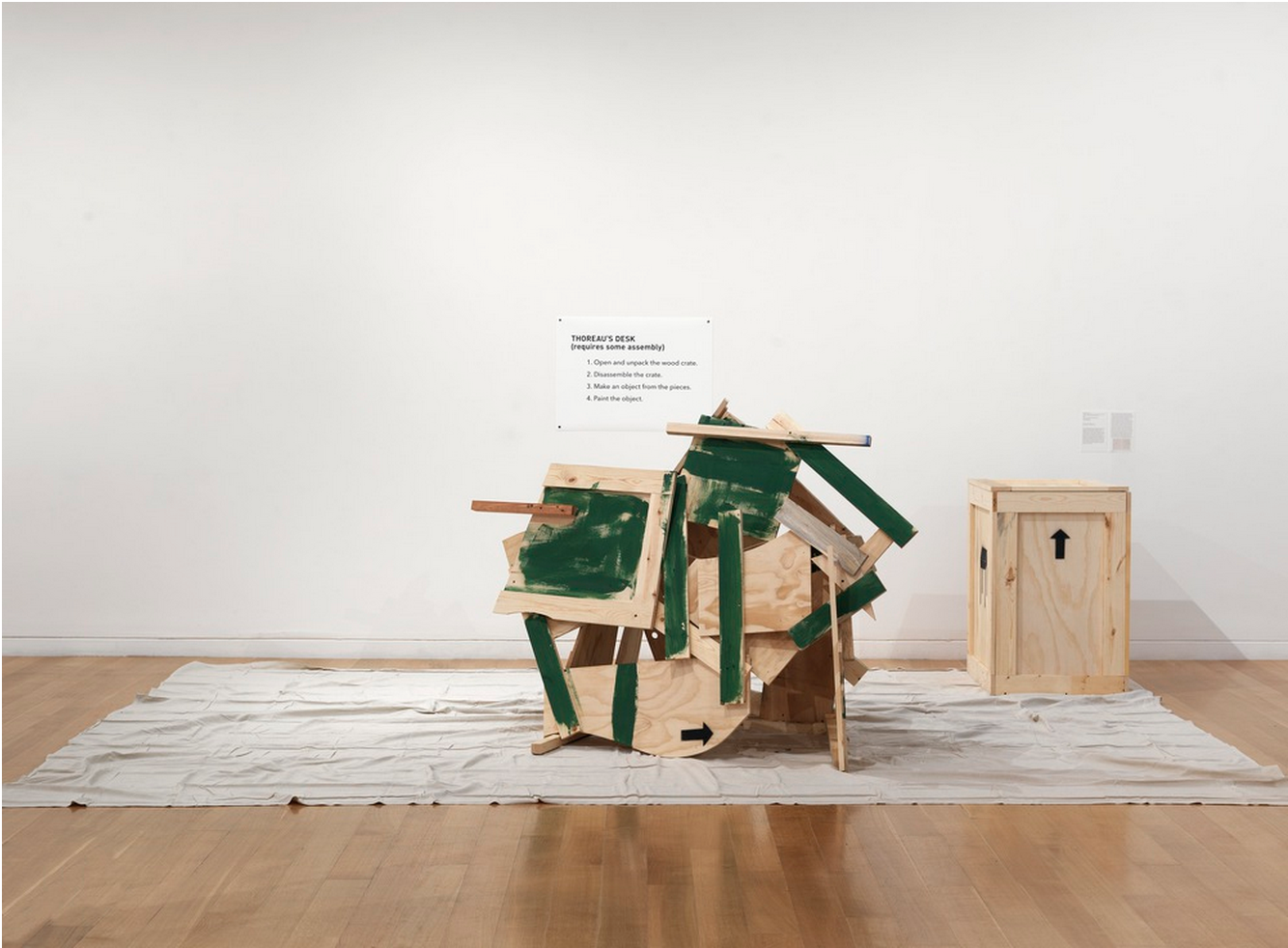
Michael Mercil, Thoreau’s Desk (requires some assembly) a composition in three or four parts for percussion trio, 2014. Wood crate, hand tools, paint, brushes, canvas cloth. Courtesy of the artist. Photo by Clements Photography and Design, Boston.
There is an exercise in the absurd that attaches to all of Thoreau. MIchael Mercil imagines a version of Thoreau’s desk (requires some assembly) which can produce a series of various outcomes, inheriting the altered instructions for the building of Buster Keaton’s doomed Cubist house in the film One Week. In another of her collaborations, this one with Monika Sziladi, Gina Siepel finds a self-conscious, innocent comedy in a "portrait of the artist" series of caricatures that read as harmless versions of what Cindy Sherman would have made unsettling. With her deadpan conclusion that "it seemed very boring to watch someone thinking for a long time,"Jennifer Sullivan speaks in a way of which Thoreau would have thoroughly approved. With a Walden pond swimming pool in her father’s back yard, where the heaps of odd junk have obviously found their natural surroundings, she still registers the accidental beauty of rain falling into the colorful piece of inflated plastic. Her work also owes something to the silent film tradition, as in the scene from Modern Times at the shack where Charlie Chaplin finds sanctuary, with its nearby pond that turns out to be only six inches deep when he dives into it for a swim. Walden may never be deep enough to hold the distortions which have attached to it, comic and otherwise
For there is a darkness in these galleries, as well. James Benning’s Two Cabins (Kaczynski/Thoreau ) addresses the inevitable comparisons between Thoreau’s cabin and the one which belonged to the Unabomber. The video work displayed through two window openings allows a viewer’s own shadow to cross into the frame, establishing an immediate sense of complicity with the invisible residents. Looking from the inside out, we are reminded of our usual perspective on the natural world which we often register as a still photograph because of our lack of patience for watching. But it is the subtleties of motion in this work which define it; it becomes a movie only when we are at our most attentive. And in an exhibition which greatly depends upon environments of sound, the whirl of noise that accompanies this particular video sequence makes all the change it registers audible, but incomprehensible. Except for the intrusion of one modern machine, we have only the most general categories of "bird" and "wind," but in what tree does that particular wind make that particular sound? This is the shared world of the murderer and the naturalist, where "God sends rain upon the just and unjust like."
Compare this to the film by William Cordova , untitled (mosaic of different origins). Here the blurred focus creates a visual time machine that allows the past to appear even as it is accompanied by overlaid sounds of the present. Cordova is also responsible for a series of collages which register as relics from what could be imagined as Thoreau’s secret journals, meant to be destroyed, but somehow salvaged in all their damaged splendor. In them, willful misspellings, the censor’s black pencil, and the brutality beneath the gilded surface of society, all leave their traces of a man like Thoreau, desperate to keep his conscience alive.
This is one of those exhibitions for which it is best to be in good company while moving through it, sharing the moments of bleak recognition that there is no way to trace the changes that most mattered to Thoreau, and sharing the laughter that keeps us hopeful, each time that paradise is lost again.

